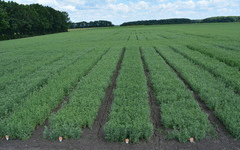Resistance of soft winter wheat varieties against pathogens of major leafstem diseases in the South of Ukraine
DOI:
https://doi.org/10.21498/2518-1017.20.2.2024.304104Keywords:
immunity, susceptibility, brown rust, stem rust, powdery mildew, donors, initial breeding materialAbstract
Purpose. To evaluate common winter wheat varieties of the Plant Breeding and Genetic Institute (PBGI) for resistance to brown and leaf rust and powdery mildew pathogens and to identify those with complex immunity to the above diseases that can be used as resistance donors in breeding practice. Methods. During 2021–2023, 35 wheat varieties of the PBGI (Wheat Breeding Department and Laboratory of Intensive Wheat Varieties) were studied. Methods of phytopathological assessment were used on separate and complex artificial infectious backgrounds of the studied diseases in the field and under artificial climatic conditions at the development stages of BBCH 12 and BBCH 59–69. Results. The varieties ‘Oktava’ and ‘Pozytsiia Odeska’ were resistant to brown rust in the juvenile and adult phases, and ‘Oktava’, ‘Vidpovid Odeska’ and ‘Pozytsiia Odeska’ were resistant to stem rust. Moderate resistance to powdery mildew was demonstrated by varieties ‘Oktava’, ‘Shchedrist’, ‘Zhytnytsia’, ‘Harantiia’, ‘Fortetsia’ and ‘Pozytsiia Odeska’ in the juvenile phase, and complex resistance to the disease group was demonstrated by ‘Oktava’ and ‘Pozytsiia Odeska’. Conclusions. The varieties with complex resistance to brown rust, leaf rust and powdery mildew justify the efforts made to develop them and are valuable for further breeding as they often do not require fungicides during cultivation.
Downloads
References
Nabok, I. I. (2018). The state of global commodity markets. Kyiv: NAU. [In Ukrainian]
Areas, gross harvests and productivity of agricultural crops. Retrieved from http://www.ukrstat.gov.ua/metaopus/2018/2_03_07_03_2018 [In Ukrainian]
Lipchuk, V., & Malakhovskyi, D. (2016). Structural changes in grain production: regional aspect. Agrarian Economy, 9(3–4), 53–60. [In Ukrainian]
Jackson, H. S. (1921). Aecial stage of the orange leaf rust of wheat, Puccinia triticina Eriks. Journal of Agricultural Research, 22, 151–172.
Babaiants, O. V., & Babaiants, L. T. (2014). Fundamentals of selection and methodology for assessing wheat resistance to pathogens. Odesa. [In Ukrainian]
Sarkhang, E. G. (2006). Biological features, specialization and virulence polymorphism of Puccinia recondita Rob. ex Desm. f. sp. tritici Erikss – the causative agent of brown leaf rust of wheat in the eastern part of the Forest-Steppe of Ukraine (Cand. Biol. Sci. Dis.). Kyiv. [In Ukrainian]
Kovalyshyna, H. M. (2010). Breeding of winter wheat at the Myronivka Wheat Institute for disease resistance. The Bulletin of Ukrainian Society of Geneticists and Breeders, 8(2), 291–299. [In Ukrainian]
Markovska, O. E., & Grechishkina, T. A. (2021). Harmfulness of Puccinia recondita Rob. ex desm. f. sp. tritici. on winter wheat in the conditions of the Southern Steppe of Ukraine. In Modern technologies and systems of plant protection: collection of materials of the All-Ukrainian scientific and practical conference (pp. 16–19). Kherson. [In Ukrainian]
Morgun, V. V., & Topchii, T. V. (2018). The importance of resistant varieties of winter wheat, the study of sources and donors of resistance to pests and major pathogens. Plant Physiology and Genetics, 50(3), 218–240. [In Ukrainian]
Downloads
Published
How to Cite
Issue
Section
License
Copyright (c) 2024 N. I. Sauliak, V. A. Traskovetska, O. A. Vasyliev, M. A. Bushulian, V. A. Rudenko, V. M Tsapenko

This work is licensed under a Creative Commons Attribution-ShareAlike 4.0 International License.
Starting in 2022, the copyright to the publication remains with the authors
Our journal abides by the CREATIVE COMMONS copyright rights and permissions for open access journals.
Authors, who are published in this journal, agree to the following conditions:
- The authors reserve the right to authorship of the work and pass the first publication right of this work to the journal under the terms of a Creative Commons Attribution License, which allows others to freely distribute the published research with the obligatory reference to the authors of the original work and the first publication of the work in this journal.
- The authors have the right to conclude separate supplement agreements that relate to non-exclusive work distribution in the form in which it has been published by the journal (for example, to upload the work to the online storage of the journal or publish it as part of a monograph), provided that the reference to the first publication of the work in this journal is included.

























 Ukrainian Institute for Plant Varieties Examination
Ukrainian Institute for Plant Varieties Examination  Селекційно-генетичний інститут
Селекційно-генетичний інститут Institute of Plant Physiology and Genetics of the National Academy of Sciences of Ukraine
Institute of Plant Physiology and Genetics of the National Academy of Sciences of Ukraine
 The National Academy of Agrarian Sciences of Ukraine
The National Academy of Agrarian Sciences of Ukraine